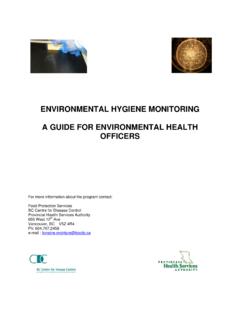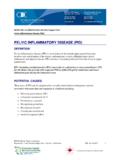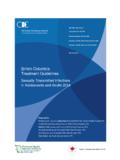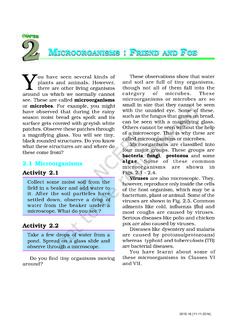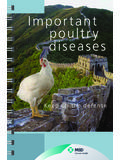Transcription of A Quick Guide To Common Childhood Diseases
1 A Quick Guide To Common Childhood Diseases May 2009 Table of Contents Introduction ..1 How are illnesses and infestations spread? .. 2 Routine 4 Handwashing .. 5 Other 8 Campylobacteriosis .. 9 Chickenpox (Varicella).. 10 Cold Sores .. 11 12 Cryptosporidiosis ( Crypto ) .. 13 E. Coli (Escherichia Coli): Diarrhea Illness and Hemolytic Uremic Syndrome .. 14 Fifth Disease (Erythema Infectiosum) .. 15 Giardiasis ( Beaver Fever ) .. 16 Haemophilus Influenzae type B (Hib) .. 17 Hand, Foot, and Mouth Disease ..18 Head Lice (Pediculosis) .. 19 Hepatitis A .. 20 Impetigo ..21 Measles ..23 Meningitis .. 24 Meningococcal 25 Methicillin-Resistant Staphylococcus Aureus (MRSA).. 26 Molluscum 27 Mononucleosis ( Mono ).. 28 Norovirus ( Norwalk virus ) .. 30 Pertussis (Whooping Cough) .. 31 Pink Eye (Conjunctivitis) .. 32 Pinworms .. 33 Respiratory Syncytial Virus ( RSV ).
2 34 35 Roseola Infantum ( Sixth Disease ).. 36 Rubella (German Measles) .. 38 Salmonellosis .. 39 Shigellosis .. 41 Shingles ..42 Streptococcal infections : Scarlet Fever and Strep Throat .. 43 Swimmer s Itch .. 44 References .. 45 1 Introduction The purpose of the Quick Guide to Common Childhood Diseases is to provide general information about communicable Diseases commonly experienced by young children. It is a Quick reference only and is intended to assist care providers with identifying Common Childhood Diseases so that actions can be taken to decrease the spread of the illness or infestation to others. Parents and caregivers who would like more information regarding the illnesses and infestations described in this Guide or information on how to care for their sick child can refer to Other Resources. The Guide is for people who care for young children.
3 This includes people who work in childcare and daycare facilities, early learning centres, preschool, school, summer camp, and anywhere else that groups of young children spend time together. When children work and play together in groups, there is an opportunity for the spread of a number of Common Childhood Diseases that can be passed on from one child to the next. Early recognition of the illness or infestation and prompt treatment can significantly reduce the spread within the group setting. The Diseases and infestations described in the Guide do not only affect children. Adults can develop symptoms and/or unknowingly spread the illness from one child to another. Each infectious disease in this Guide is described according to: What is it? Basic facts about the infectious disease A list of some of the signs and symptoms (not every child will have every symptom of the illness) How is it spread?
4 Description of how the illness or infestation is passed from child to child Incubation Period Length of time from when the child is first exposed to the illness to when the first symptoms appear in that child When is the person contagious? Description of the time period when an infected child is able to spread the illness or infestation to others How to prevent spread of the illness / infestation to other children Information regarding whether or not the child needs to be excluded from the school or child care facility Strategies to decrease the spread of the illness within the group setting. 2 How are illnesses and infestations spread? Most of the infections in this Guide are transmitted through direct and indirect contact with the nose and throat secretions of an infected person. This can happen when: An infected person coughs or sneezes without a tissue to cover their nose and mouth.
5 Tiny droplets containing the virus or bacteria travel through the air and can infect a person who is close (less than a meter away). An infected person may have the virus or bacteria on their hands after wiping their eyes or nose, coughing, or sneezing. If they touch another person s hand or an object, the virus or bacteria may be left behind. The virus or bacteria can infect the next person when that person touches their eyes, nose, or mouth. Some viruses and bacteria can remain on surfaces like doorknobs, faucets, telephones, and toys for many hours. People working with groups of children assist children with using or disposing of tissues. When the tissue is contaminated with the nose and throat secretions of an infected child, the virus or bacteria is readily transmitted to the hands of the staff member when they touch the tissue. Several of the infections affect the gastrointestinal system (stomach and bowel).
6 The bacteria or virus is often found in contaminated food or water but can be transmitted person to person, especially in a child care facility where children are in diapers. These viruses and bacteria are primarily transmitted when: Contaminated food is not cooked or cleaned properly. Contaminated water is not treated properly. There is direct contact with the stool (feces) of an infected person. This might happen when a caregiver changes a child s diaper or assists a child with toileting. Even a tiny amount of stool on a caregiver s hand may contain virus or bacteria and infect them if they directly touch their mouth or prepare food before handwashing. There is indirect contact with infected stool. This might happen when a person with the virus or bacteria on their hands touches an object ( , faucet, light switch, door knob, or toy). The virus or bacteria can live on the object for long periods of time and be transmitted to anyone who touches the object.
7 3 Head lice is an infestation, not an infection. Head lice do not cause illness. Ringworm, scabies, and pinworms can cause infections and illness. Head lice, ringworm, scabies, and pinworms are spread by direct contact with a person who has them when: People are very close together and skin or hair is touching. A person touches the affected area and then touches the hands or skin of another person. Sharing combs, hair brushes, hats, helmets, or headphones. 4 Routine Practices Cover your mouth and nose with a tissue when you cough or sneeze. Teach children to sneeze or cough into the inner arm where the elbow flexes instead of sneezing or coughing into their hands. This method decreases the spread of disease from infection on the hands. Do not share personal items such as hairbrushes, hats, toothbrushes, facecloths, towels, sippy cups, or bottles.
8 Wear disposable gloves anytime your hands may come into contact with blood or body fluid. This is especially important if you have a cut or open sore on your hands. Use household rubber gloves when cleaning or sanitizing. Dispose of articles soiled with discharge from nose and/or mouth, vomit, or feces into a disposal bin, ideally with a pop-up lid. The bin should be lined with a disposable plastic bag to be tied and thrown out with the household/childcare facility garbage. Disinfect surfaces using a diluted bleach solution. A solution of 1:100 or 1:50 is recommended for routine disinfection of surfaces and objects. A bleach solution loses potency when stored. If a 1:100 solution is used, it loses effectiveness after 24 hours. A 1:50 solution remains effective for 30 days. 1:100 is 1 part bleach to 100 parts water (5 ml bleach to 500 ml water). 1:50 is 1 part bleach to 50 parts water (10 ml bleach to 500 ml water).
9 1 part bleach to 10 parts water (5 ml bleach to 50 ml water) is recommended for cleaning up spills of blood or body fluids. * Organic material such as blood or stool inactivates bleach. A surface obviously contaminated with blood or stool must be cleaned with water and detergent before being disinfected. Clean and disinfect countertops, toys, and diaper changing areas more frequently when a child with diarrhea is present. Prepare food safely: Cook meat and poultry well. Avoid drinking or serving unpasteurized milk and juice. Thoroughly wash all fruits and vegetables before eating or serving. Keep uncooked meat away from fruit and vegetables. Cover food and store at recommended temperatures for recommended times. 5 Handwashing Handwashing is the best way to stop the spread of infections . Eighty percent of Common infections are spread by hands. Washing hands at least five times a day has been shown to significantly decrease the frequency of colds, flu, and other infections .
10 When to Wash Your Hands Caregivers should wash hands: Before preparing food Before feeding a child or eating After using the washroom or helping a child use the washroom Before and after changing diapers After blowing your nose or wiping a child s nose Before performing first aid or applying a band-aid Before applying sunscreen After handling pets or other animals After cleaning or handling garbage Children should wash hands: Before eating or helping with food preparation After using the washroom After sneezing, coughing or using a tissue After playing with toys shared with other children Before and after playing at the water table After playing outside or in the sandbox After handling animals or animal waste How to Wash Your Hands Use regular soap that does not contain antibacterial agents.


